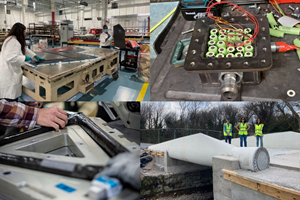What a difference a year makes
If 2020 was bad, then 2021 can only be better. CW Editor-in-Chief Jeff Sloan discusses the promising and not-so-promising industry trends leading up to 2021.

Photo Credit: Getty Images
Although it is objectively true that 2020 is, on balance, one of the worst years of the last century lived by humans, it will be quite a while before we understand thoroughly how history will judge the Year of the Pandemic.
However, now that the year is officially in the rearview mirror, and now that the distribution of vaccines is providing us a slight glimpse of what might be the faintest glimmer of a light at the end of the COVID-19 tunnel, we might start thinking about what 2020 has wrought, and what it means for the composites industry.
First, we should acknowledge the asynchronous nature of the economic downturn that the coronavirus pandemic wrought. Unlike a traditional recession, which strikes broadly and uniformly, the brakes applied to the composites industry by COVID-19 were not felt homogeneously.
The wind energy industry, for example, after a short lull in the spring when pandemic-induced shutdowns began, soon returned to pre-COVID-19 form and is expected to end 2020 in record-setting fashion. The American Wind Energy Assn. (AWEA, Washington, D.C.) reported in October 2020 that the third quarter of 2020 saw the U.S. install 2,000 megawatts (MW) of wind power — a record for any third quarter in the U.S. Further, the U.S. was on pace to install more wind power in 2020 than any previous year, with installations through the third quarter up 72% compared to the same period in 2019. Much of this activity likely was spurred by the Production Tax Credit (PTC), which expired on Dec. 31, 2020, but that should not diminish our admiration for what the entire wind industry supply chain accomplished in very difficult circumstances.
Similarly, with the downturn in air travel, and with governments limiting indoor gatherings, many people sought outdoor activities for leisure pursuits and to safely escape the pandemic. Thus, recreational vehicle (RV), recreational marine, bicycle and fishing rod sales increased significantly. The RV Industry Assn. (RVIA, Reston, Va., and Elkhart, Ind., U.S.) in September 2020 reported that shipments of RVs were expected to have surpassed 400,000 wholesale units in the U.S. by the end of 2020 (a 4.5% increase over 2019) and see continued growth in 2021 to more than 500,000 units.
The National Marine Manufacturers Assn. (NMMA, Chicago, Ill., U.S.) reported in October 2020 that power boat retail sales had increased 8% year to date (YTD) compared to the same period in 2019. Sales of personal water craft (PWC), pontoons and freshwater fishing boats were up 2%, 9% and 10% respectively YTD, while sales of saltwater fishing boats, tow boats, cruisers and yachts each had growth ranging from 11% to 15%, compared to 2019.
The pandemic also clarified and possibly accelerated some trends in the automotive industry that were already at work. The most notable is the global shift away from internal combustion engine (ICE) vehicles and toward electric vehicles (EV). The International Energy Agency (IEA) says overall passenger vehicle sales in 2020 are expected to drop about 15% compared to 2019, but that EV sales will be flat. And Bloomberg NEF says the EV average vehicle price will drop below the average ICE vehicle price by 2025, and that EV sales will exceed ICE vehicle sales by 2037. CW columnist Dale Brosius outlines the EV opportunity for the composites industry in greater detail.
If wind, recreation and EV sales are the silver lining, then the darkest, biggest cloud of 2020 is the aerospace industry, which, by value, is the most important end market served by the composites industry. Passenger air travel has been so diminished by the pandemic that one can say, with substantial confidence, that things can only get better. But even that will take time, led first by a recovery in domestic air travel, followed by 2025 or so, a return to “normal” international air travel. Aviation Week, in a mid-December forecast, said to expect new global commercial aircraft deliveries to increase to about 1,350 in 2021, followed by incremental annual increases through 2030. Still, an estimated output of 1,750 by that year takes us back to 2017 levels only, and a far cry from the 2018 high-water mark of 1,800+ aircraft. Still, it’s an enouraging return to growth.
The big question facing the aerospace industry now is if and when a new aircraft program might be announced. And who might announce it. I will address that next month. In the meantime, happy 2021, and stay safe.
Related Content
A return to JEC World
CW editor-in-chief Scott Francis reflects on the ways in which the composites industry has changed and also stayed the same based on observations from this year’s JEC World.
Read MoreRemembering Don Adams
When one thinks of composites test methods, one thinks of Don Adams. Don passed away at the end of 2022. We remember him here.
Read MoreThe real value of CompositesWorld
Will CW editor-in-chief Jeff Sloan soon be replaced by ChatGPT? Probably not before he retires, but it’s fun to consider the possibility.
Read MoreAs 2023 begins, a look back at trending CW topics in 2022
With 2022 now behind us, CW’s editor-in-chief Jeff Sloan takes a look at the CW stories last year that received the most reader attention.
Read MoreRead Next
Plant tour: Daher Shap’in TechCenter and composites production plant, Saint-Aignan-de-Grandlieu, France
Co-located R&D and production advance OOA thermosets, thermoplastics, welding, recycling and digital technologies for faster processing and certification of lighter, more sustainable composites.
Read MoreDeveloping bonded composite repair for ships, offshore units
Bureau Veritas and industry partners issue guidelines and pave the way for certification via StrengthBond Offshore project.
Read MoreVIDEO: High-volume processing for fiberglass components
Cannon Ergos, a company specializing in high-ton presses and equipment for composites fabrication and plastics processing, displayed automotive and industrial components at CAMX 2024.
Read More






















